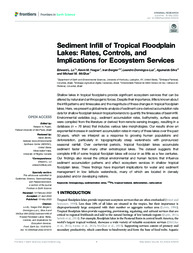Sediment infill of tropical floodplain lakes: rates, controls, and implications for ecosystem services.
Sediment infill of tropical floodplain lakes: rates, controls, and implications for ecosystem services.
Autoria: LO, E. L.; YEAGER, K, M.; BERGIER, I.; DOMINGOS-LUZ, L.; SILVA, A.; MCGLUE, M. M.
Resumo: Shallow lakes in tropical floodplains provide significant ecosystem services that can be altered by natural and anthropogenic forces. Despite their importance, little is known about the infill patterns and timescales and the magnitude of these changes in tropical floodplain lakes. Here, we present a global meta-analysis of sediment core-derived accumulation rate data for shallow floodplain lakes in tropical lowlands to quantify the timescales of basin infill. Environmental variables (e.g., sediment accumulation rates, bathymetry, surface area) were compiled from the literature or derived from remote sensing imagery, resulting in a database (n = 76 lakes) that includes various lake morphologies. Our results show an exponential increase in sediment accumulation rates in many of these lakes over the past 50 years, which we interpret as a response to growing human populations and deforestation, particularly in topographically steep watersheds with pronounced seasonal rainfall. Over centennial periods, tropical floodplain lakes accumulate sediment faster than many other extratropical lakes. The dataset suggests that complete infill of some tropical floodplain lakes will occur in as little as a few centuries. Our findings also reveal the critical environmental and human factors that influence sediment accumulation patterns and affect ecosystem services in shallow tropical floodplain lakes. These findings have important implications for water and sediment management in low latitude watersheds, many of which are located in densely populated and/or developing nations.
Ano de publicação: 2022
Tipo de publicação: Artigo de periódico
Unidade: Embrapa Pantanal
Palavras-chave: 210Pb, Chumbo, Deforestation, Desmatamento, Limnogeology, Planície tropical, Radiocarbon, Radiocarbono, Sedimentation rates, Taxa de sedimentação, Tropical lowland
Observações
1 - Por padrão são exibidas publicações dos últimos 20 anos. Para encontrar publicações mais antigas, configure o filtro ano de publicação, colocando o ano a partir do qual você deseja encontrar publicações. O filtro está na coluna da esquerda na busca acima.
2 - Para ler algumas publicações da Embrapa (apenas as que estão em formato ePub), é necessário ter, no celular ou computador, um desses softwares gratuitos. Sistemas Android: Google Play Livros; IOS: iBooks; Windows e Linux: software Calibre.
Acesse outras publicações
Acesse a Base de Dados da Pesquisa Agropecuária (BDPA) para consultar o acervo completo das bibliotecas da Embrapa.

